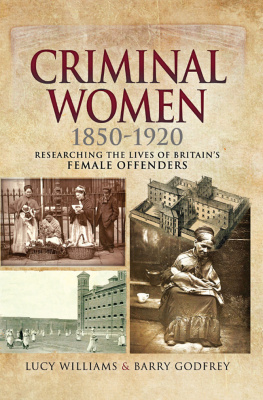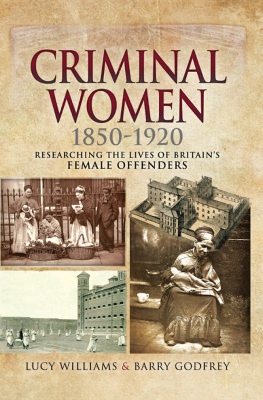Pagebreaks of the print version

CRIMINAL WOMEN 18501920
FAMILY HISTORY FROM PEN & SWORD
Tracing Secret Service Ancestors
Tracing Your Air Force Ancestors
Tracing Your Ancestors
Tracing Your Ancestors from 1066 to 1837
Tracing Your Ancestors Through
Death Records
Tracing Your Ancestors Through
Family Photographs
Tracing Your Ancestors Using the Census
Tracing Your Ancestors Childhood
Tracing Your Ancestors Parish Records
Tracing Your Aristocratic Ancestors
Tracing Your Army Ancestors 2nd Edition
Tracing Your Birmingham Ancestors
Tracing Your Black Country Ancestors
Tracing Your British Indian Ancestors
Tracing Your Canal Ancestors
Tracing Your Channel Islands Ancestors
Tracing Your Coalmining Ancestors
Tracing Your Criminal Ancestors
Tracing Your East Anglian Ancestors
Tracing Your East End Ancestors
Tracing Your Edinburgh Ancestors
Tracing Your First World War Ancestors
Tracing Your Great War Ancestors:
The Gallipoli Campaign
Tracing Your Great War Ancestors: The Somme
Tracing Your Great War Ancestors: Ypres
Tracing Your Huguenot Ancestors
Tracing Your Jewish Ancestors
Tracing Your Labour Movement Ancestors
Tracing Your Lancashire Ancestors
Tracing Your Leeds Ancestors
Tracing Your Legal Ancestors
Tracing Your Liverpool Ancestors
Tracing Your London Ancestors
Tracing Your Medical Ancestors
Tracing Your Merchant Navy Ancestors
Tracing Your Naval Ancestors
Tracing Your Northern Ancestors
Tracing Your Pauper Ancestors
Tracing Your Police Ancestors
Tracing Your Prisoner of War Ancestors:
The First World War
Tracing Your Railway Ancestors
Tracing Your Royal Marine Ancestors
Tracing Your Rural Ancestors
Tracing Your Scottish Ancestors
Tracing Your Second World War Ancestors
Tracing Your Servant Ancestors
Tracing Your Service Women Ancestors
Tracing Your Shipbuilding Ancestors
Tracing Your Tank Ancestors
Tracing Your Textile Ancestors
Tracing Your Trade and Craftsmen Ancestors
Tracing Your Welsh Ancestors
Tracing Your West Country Ancestors
Tracing Your Yorkshire Ancestors
CRIMINAL WOMEN 18501920
Researching the Lives of Female Criminals in Britain and Australia
Lucy Williams and Barry Godfrey
First published in Great Britain in 2018 by
Pen & Sword Family History
an imprint of
Pen & Sword Books Ltd
47 Church Street
Barnsley
South Yorkshire
S70 2AS
Copyright (c) Lucy Williams and Barry Godfrey 2018
ISBN 978 1 52671 861 7
eISBN 978 1 52671 863 1
Mobi ISBN 978 1 52671 862 4
The right of Lucy Williams and Barry Godfrey to be identified as Authors of this Work has been asserted by them in accordance with the Copyright, Designs and Patents Act 1988.
A CIP catalogue record for this book is available from the British Library
All rights reserved. No part of this book may be reproduced or transmitted in any form or by any means, electronic or mechanical including photocopying, recording or by any information storage and retrieval system, without permission from the Publisher in writing.
Pen & Sword Books Ltd incorporates the imprints of Pen & Sword Archaeology, Atlas, Aviation, Battleground, Discovery, Family History, History, Maritime, Military, Naval, Politics, Railways, Select, Social History, Transport, True Crime, and Claymore Press, Frontline Books, Leo Cooper, Praetorian Press, Remember When, Seaforth Publishing and Wharncliffe.
For a complete list of Pen & Sword titles please contact
PEN & SWORD BOOKS LIMITED
47 Church Street, Barnsley, South Yorkshire, S70 2AS, England
E-mail:
Website: www.pen-and-sword.co.uk
Part 1
BACKGROUND
Chapter 1
INTRODUCTION
R ecords of crime and disorder created by the British state between 1850 and 1925 are some of the most voluminous of all those available for the study of ordinary people in the last two centuries. However, while we might suppose that this would make the history of crime and criminals one of the easier histories to uncover, creating a criminal biography can leave us with a nasty shock. Unless you are tracing one of the handful of criminal celebrities in the nineteenth century, you may find this more difficult than you first imagine. People who broke the law usually had a vested interest in not being found. They used aliases, regularly changed addresses and werent always the most truthful when officials asked them for details information we rely on to find them and learn about their lives more than a century later. Female offenders can be amongst the hardest characters of all to find. Not only were they, like male offenders, keen to escape the eye of the authorities, but by virtue of being women, their identities were more changeable and their lives were less consistently recorded.
Family historians have long laboured to trace female relatives whose names might change at any time as they married, whose occupations were often ignored or misreported in civil records, and whose details might be left off vital household documents that were usually filled in by men. Those tracing criminal women will come across these same frustrating problems, and more besides. Female offenders might use professional aliases, or change their names on marriage, just like our other female ancestors, but they were also more likely than other groups of women to adopt new surnames at will, for example when in a long-term but not legally recognised relationship. Women might do this multiple times over the course of their adult lives. Criminal women might also be more likely than their stable peers to have illegitimate children, whose births were never registered, and fathers never publicly acknowledged. From their early lives, women who ended up in the court dock may have regularly moved addresses, been passed around family members or been in and out of institutions around the country, leaving researchers scratching their heads in the attempt to piece together a credible journey.
Moreover, the dysfunctional lives that led many women into prisons, reformatories, transportation ships, lock hospitals and inebriates homes also meant that the women we are looking for did not always have the clearest sense of their own details and histories. The women we find in these institutions might never have known the exact date and year of their birth, or may have had little cause to remember it in their adult lives. As such they might regularly misreport their age or place of birth by accident, giving changeable and conflicting estimates as they went through life. There were of course also those women who were intentionally vague about their details to census enumerators, courts and police officers in the hope of avoiding apprehension, identification, conviction or simply out of a sense of fun or mischief.
We are therefore often left in the position of tracing women who not only did not want to be found, and who, through little fault of their own, leave us with conflicting information about where and when they were born, how they made a living, or where we might find them. These women probably never anticipated that over a hundred years later we would be looking for them, eager to tell stories about their lives.










